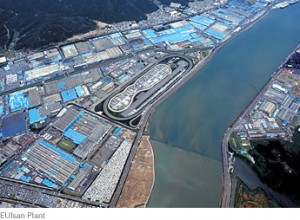On cue vehicles sales dropped as the federal “cash for clunkers” program ran expired after helping pick up sales for almost two months. Overall, sales were down 22.7% compared to September 2008 and down 27.4% for the year.
The seasonally adjusted annual rate (SAAR) for light vehicles now stands at 9.22 million, compared to 12.57 million units in September 2008.
Ford Motor Company has the relatively best month among the former Big Three. Ford’s sales slipped only 6% in September allowing it to pick up share on its sluggish competitors ranging from General Motors and Toyota to Mercedes-Benz and smart.
GM and Chrysler continued to post enormous drops in sales. Sales at both companies dropped roughly 42%. Chrysler will struggle to sell 1 million vehicles this year. Ford could wind up building more vehicles than GM — the first time since Republican Herbert Hoover was president and ushered in the Great Depression, or maybe it was under “silent” Calvin Coolidge that Ford beat GM.
Meanwhile, Toyota reported a 16% drop in sales. Honda sales fell 22%. Mazda has dropped 12%. Nissan’s fell 7%. Audi sales also dropped 5%.
Hyundai and Kia each posted strong sales during September. Kia’s sales climbed 24%, while Hyundai has increased 27% as both companies benefited from the extension of their product lines.
Volkswagen also reported small but arguably significant increases in sales, partly because Chrysler had resumed shipments of the Routan minivan to VW dealers. Without the Routan, VW would have had negative numbers. As it has all year long, Subaru also posted an increase, as did BMW with help from the Mini-brand.
Mercedes-Benz sales dropped 9.6%. The new E-Class did well but the rest of the line continued to feel the impact of shift in American spending habits away from luxury vehicles. Smart also saw its sales decline in September.
Daimler officials remain optimistic about the Mercedes-Benz outlook. Nevertheless, even though Dieter Zetsche talks optimistically about the recession receding, the competitive and economic landscape seems tilted against the storied brand. Audi is pushing aggressively into Benz preserves, and if the new Panamera is as successful as Porsche executives believe it will be, it is certain to draw buyers away from the E-Class and S-Class sedans.
Archrival BMW also seems to have developed a more coherent post-recession strategy to boost fuel economy and luxury all across its product line.
Nevertheless, the excuse factory in Stuttgart has not taken on extra shifts just yet.
Not so at Daimler’s former ward, Chrysler, which is still reeling from the financial crisis that began last fall?
“While we had some bright spots in September, it was still a challenging sales environment for the industry,” said Peter Fong, President and Chief Executive Officer-Chrysler Brand and Lead Executive for the Sales Organization, Chrysler Group LLC.
“Low inventories of popular models at the start of the month hampered Chrysler, Jeep and Dodge sales. However, the company responded with increased production. The company finished the month with increased market share compared with August 2009,” Fong said.
“We believe the remainder of 2009 will continue to be a challenge for the U.S. automotive market. Credit markets have thawed slightly, but still remain tight, and consumer confidence, as we saw in September, is tenuous,” added Fong, who, like a chess master, was setting up his defenses in anticipation of what comes next.
GM also blamed its poor showing on low inventories, created by the CARS, aka Clunkers taxpayer giveaway.
“As expected, the market returned to pre-Cash for Clunkers levels in September, but we believe that our four core brands – Chevrolet, GMC, Buick and Cadillac – are well positioned with new products to generate enthusiasm with our 60-Day Satisfaction Guarantee and ‘May the Best Car Win’ marketing campaigns,” said GM vice president for sales Mar LaNeve.
“We’re gearing-up fourth quarter production to replenish depleted dealer stocks and improve availability of our vehicles for customers,” LaNeve said.
Ford, however, managed its way around the inventory draw down and even claimed promising signs for the future. The new Taurus is getting to a strong start and sales of F-150 are more than holding their own, although with heavy use of incentives.
If Ford emerges from the recession with a larger share of full-size truck market, it will hold a formidable competitive position that both its offshore and domestic rivals will have difficulty challenging.

